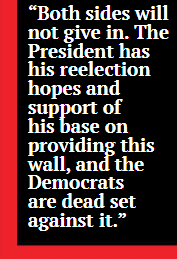State divided: Political factors that have lead to a governmental divide
Factors leading up to shutdown including lack of compromise and a divided government.

February 8, 2019
The second government shutdown of Donald Trump’s presidency began on Dec. 22 and persisted to Jan. 27, becoming the longest government shutdown in U.S. history at 36 days. A government shutdown stems from the Antideficiency Act, which is implemented when Congress fails to pass bills or funding for federal projects, or when the President refuses to sign laws or bills. For some government workers, the shutdown means they are required to work without pay; for others, they were placed on furlough, which means that they do not work or get paid.
A stalemate between Trump and Congress prompted this shutdown, with Trump demanding government funding on the U.S.-Mexico border wall that he promised as part of his presidential campaign in 2016. While Trump blames Democrats for stalling funding for the wall, saying over Twitter that they are “having fun” as government employees suffer under the shutdown, Democrats have criticized Trump for enacting the shutdown in the first place.

Senior and president of Politics Club Adamya Srivastava attributes the shutdown to the “split government,” a phenomenon that occurs when Republicans control one aspect of Congress and Democrats the other. In this case, Republicans control the Senate, while Democrats control the House of Representatives.
“[The current government shutdown] is going to set a pretty harsh precedent where the President can ask for funding for any program that he or she finds isn’t getting enough support in Congress,” Srivastava said. “He can basically bypass appropriating funds for the program.”
De Anza College professor of political science Gregory Druehl says that while a shutdown similar to the current one has happened before, it had not lasted this long. The shutdown in 1995-96, lasting 26 days, was once considered the longest government shutdown in U.S. history. At that time, Democrat president Bill Clinton was clashing with a Republican-dominated Congress over a conflict regarding funding for Medicare, among other issues of debate like public health, education and the environment. In Druehl’s opinion, it was ultimately Clinton’s charismatic nature that brought enough pressure onto Congress to end the shutdown.
“He was so popular that the Republicans had to give in because it made them look so bad President Clinton would go on TV and say, ‘Those stupid Republicans in Congress, they don’t know what they’re doing, they need to pass the legislation that I want them to and then the parks will reopen and we all will live happily ever after,’” Druehl said. “And the Republicans actually gave up, passed a law that made President Clinton happy, he signed it and they lived happily ever after.”
At the moment, Druehl doesn’t view the closure of non-essential government functions like the National Park Service or NASA as a major issue. Though he acknowledges the people who are negatively impacted, he says that this situation isn’t near the scale that it is purported to be. Out of a $4 trillion budget, $5 billion has been set aside for the wall in question, a miniscule amount by comparison. Furthermore, while it is true that 800,000 federal government employees, according to CNBC, have been impacted by their furloughs, not all government employees are going without pay. Only those part of the nine affected departments — Homeland Security, Justice, State and Treasury, and several agencies, including the Environmental Protection Agency and NASA — will have their salaries delayed until the end of the shutdown, as they were deemed “essential” and required to work.

Druehl believes that both parties are treating the situation as a way to make themselves look favorable by comparison. A good public image would be crucial for both of them, especially as the 2020 presidential election looms nearer, says Druehl, and Democrats are taking the opportunity to dramatize the shutdown that was started by a Republican president in order to gain an advantage.
“Trump’s talking about rapists coming across the border and terrible people entering the country, the Democrats are going, ‘He’s starving government workers and denying poor people a chance to live in America,” Druehl said. “So both sides have some good arguments, but I think a lot of it is posturing.”
Although De Anza political science department chair James Nguyen agrees that image comes into play in this situation, he believes that the shutdown’s effects are felt beyond government workers’ pay and political stances. While he says that a lack of political pressure contributed to the shutdown in the first place, both the Democratic Party and the President’s unwillingness to compromise on the potential border wall were also major factors that led to crumbling negotiations. Ultimately, Democrats secured a victory in ending the shutdown, but at this time it’s hard to say whether history will repeat itself after the government re-enters shutdown.
“Here are both sides [that] are completely dug in,” Nguyen said. “Both sides will not give in. The President has his reelection hopes and support of his base on providing this wall, and the Democrats are dead set against it.”
Nguyen believes that even after there is a resolution, the effects of the shutdown will echo into the upcoming election and the future of politics. Currently, the effects of furloughing government workers can be felt across the nation; TSA workers are calling in sick en masse, impacting major airports. As a result, travel has been inconvenient at best and hazardous at worst, with videos circulating on social media of long lines.
“I mean, that’s what we’re talking about, the safety of airplanes and domestic flights,” Nguyen said. “So border security agents, who don’t work I mean, that could be the real border security crisis. Some people believe that there really is no real crisis except for the one that’s been created now, with the shutdown, [and] that the shutdown is creating more of a safety and security concern, than the crisis that the President went on TV to discuss.”
President Trump has since announced that he will reopen the government, starting negotiations lasting 21 days with the Democratic party to move ahead with his border wall. The government reopening began on January 27. Trump has expressed an intent to shutdown the government again after those 21 days have passed.


















